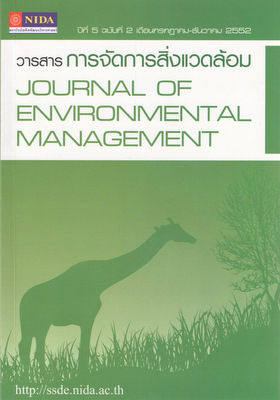การประเมินผลกระทบสิ่งแวดล้อมโดยใช้ LCAเป็นเครื่องมือในการจัดการหลอดฟลูออเรสเซนต์ที่ใช้แล้ว/Environmental Impact Evaluation Using LCA Tool for Spent-Fluorescent Waste Management
บทคัดย่อ
งานวิจัยนี้ได้จัดทำทั้งแบบเชิงนโยบายและเชิงเทคนิค โดยในส่วนของเชิงนโยบายพบว่า มหาวิทยาลัยธรรมศาสตร์ได้ดำเนินการจัดการเข้าร่วมโครงการเรียกคืนซากหลอด ฟลูออเรสเซนต์ กับกรมควบคุมมลพิษโดยในส่วนนี้สามารถครอบคุมได้เพียง 28% และในส่วนเชิงเทคนิคได้ทำการ ศึกษาสภาวะที่เหมาะสมในการกำจัดสารปรอทโดยใช้ปริมาณสารโซเดียมซัลไฟด์ใน อัตรา 1 เท่า และ 2 เท่า โดยปริมาณสารปรอทที่ใช้ในการทดลองมีค่าความเข้มข้นเท่ากับ 10 mg/l พบว่าการใช้ สารโซเดียมซัลไฟด์ 1 เท่า มีค่าประสิทธิภาพในการกำจัดสารปรอทได้มากกว่า 96% จากผลการ ทดลองที่ได้นำไปทำการประเมินผลกระทบสิ่งแวดล้อมของการกำจัดหลอดฟลูออเรส เซนต์แบบ รีไซเคิลและแบบไม่รีไซเคิล โดยเทคนิคการประเมินวัฏจักรชีวิต จะทำให้ได้ทราบค่าเชิงปริมาณและ แสดงให้เห็นถึงผลกระทบต่อสิ่งแวดล้อมในด้านต่างๆ ของการกำจัดซากหลอดฟลูออเรสเซนต์ ขอบเขตการศึกษาของวัฏจักรชีวิตของซากหลอดฟลูออเรสเซนต์ จะศึกษาเฉพาะส่วนการ กำจัดหลอดฟลูออเรสเซนต์ที่หมดอายุจากการใช้งานแล้วเท่านั้น ผลจากการประเมินผลกระทบ สิ่งแวดล้อมโดยใช้โปรแกรม Sima Pro 7.1 วิธี Eco-indicator 99 พบว่า การกำจัดซากหลอด ฟลูออเรสเซนต์แบบรีไซเคิลมีผลกระทบด้านความเป็นพิษต่อระบบนิเวศในปริมาณที่ ลดลงจากค่า 9x10-3 PDF/m2 /year เหลือ -1.8x108 PDF/m2 /year
This research investigated the spent fluorescent management in both policy planning and technical technique. This work has been done using Thammasat University as a sample model. The university has signed waste management cooperation with Pollution Control Department to revoke and recycle spent fluorescents in a standard process. Approximately 28% of spent fluorescents could be taken care. For the technical issue, mercury vapor (one of the hazardous materials in spent fluorescents) was treated using sodium sulfide at the ratio of 1:1 and 2:1. Initial concentration of mercury was set at 10 mg/l. It was found that sodium sulfide solution with ratio of 1:1 performed the best mercury removal of more than 96%. This result was then used to evaluate the environmental impacts of both recycle and non-recycle fluorescent disposal processes using LCA tool. Sima Pro 7.1 with the Eco-indicator 99 method was used. It was found that the spent fluorescents management with solidification and glass recycle system could reduce environmental impact of ecosystem from 9x10-3 PDF/m2 /year to - 1.8x108 PDF/m2 /year.



